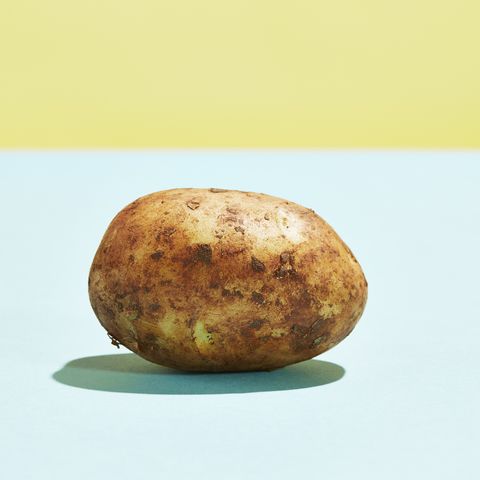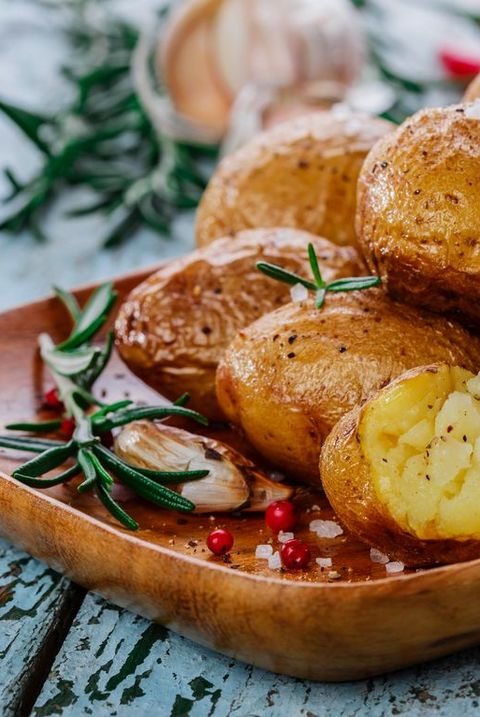Home » Diet & Food »
Why Potatoes Are Actually Good for You
The poor potato has been through so much.
The Irish Potato Famine in the 19th century. The bastardization of it into Mr. Potato Head, a toy in which you anthropomorphize the tuber by stabbing it with body parts as an excuse for “fun,” in the 20th century. And now, in the 21st century, the potato has become a nutritional pariah due to the fear-mongering of anti-carb zealots.
Yes, potatoes are a carbohydrate. But they are so much more than a carbohydrate. And unfairly lumping taters into a class of carbohydrates also shared by sugar and refined white bread is not only misleading, it’s detrimental to overall health.
It’s time to reclaim the potato from the “experts” who say that you should never eat the vegetable if you want to lose weight, build muscle, and avoid diabetes.
It’s time to give potatoes a break after their long, hard road.
It’s time to restore potatoes to all their nutritional glory.

Richard Drury
Wait, so potatoes will not cause me to gain weight?
Not unless you’re eating a godawful amount of potatoes.
You can track this whole potatoes-will-make you fat myth from the proliferation of the glycemic index. Also known as the GI index, this system assigns a numeric value to foods based upon the speed at which they would affect your blood sugar levels.
If a food has a high GI index value, that food may spike your blood glucose levels. For people suffering from diabetes, spikes in blood glucose levels, and the crash that follows, can be dangerous.

Katrin Sauerwein / EyeEm
If a food has a low GI index value, that food would release glucose much slower, avoiding the health complications associated with high and low blood glucose levels in diabetics.
(A quick note here that the GI index value of a food is not a universal value, and people may respond to certain foods differently, at least according to this 2016 study in The American Journal of Clinical Nutrition. In short, the GI index may not be rock-solid in terms of reliability.)
Low glycemic foods include fruits, beans, and “non-starchy” vegetables.
High glycemic foods include white bread, cornflakes, rice crackers, and … wait for it … white potatoes.
In 2011, The New England Journal of Medicine made things even worse for spuds.
The review concluded this: “Foods that contained higher amounts of refined carbohydrates — whether these were added (e.g., in sweets and desserts) or were not added (e.g., in refined grains) — were associated with weight gain in similar ways, and potato products (which are low in sugars and high in starches) showed the strongest associations with weight gain.”
A chart in that study shows that “potato chips” followed by “potatoes or fries” had the greatest effect on weight gain—more than meat, butter, and even desserts.

lolostock
But also in the study were these lines: “Although dietary questionnaires specified portion sizes, residual, unmeasured differences in portion sizes among participants might account for additional independent effects on energy balance. For example, an average, large baked potato contains 278 calories, as compared with 500 to 600 calories for a large serving of french fries. The typical portion size of a specific food or beverage may therefore partly mediate its effects on weight gain (i.e., both average portion sizes and biologic effects).”
And herein lies the potato problem: portions.
Although the debate over the glycemic index rages on, there’s one thing that’s clear—if you’re eating too much of any food, be it salmon or tofu or peanuts or potatoes, you’re going to be adding an influx of calories to your diet. And if you aren’t expending those calories you may be at risk for weight gain.
Anyone who has ever eaten a large baked potato knows that it’s challenging to eat a large plain baked potato. You fill up quickly and your taste buds grow bored of the lack of flavor.

Kostyantyn Manzhura / EyeEm
Anyone who has ever eaten a large side of french-fried potatoes knows that it’s easy to eat a large side of french-fried potatoes. You can keep eating them in all their greasy, salty glory and never grow bored until they’ve vanished from your plate.
Science has lumped processed and whole potato products together in the past, and “experts” within the nutrition world have further complicated matters by calling all potatoes belly-fat-producing gut bombs, when the truth might be more nuanced.
The question isn’t only what kind of potato are you eating, but how much?
Okay, well, aren’t white potatoes totally devoid of nutrition anyway?
No.
In fact, no food that Mother Nature has created is nutritionally devoid. Not iceberg lettuce (antioxidants!). Not celery (fiber!). And sure as heck not potatoes.
Potatoes are an excellent source of potassium, a nutrient most people don’t consume enough of, which can help regulate your blood pressure. They’re a good source of vitamin C and vitamin B6, which aids your nervous and immune systems.
One large baked potato, with skin, contains 8 grams of protein and a whopping 7 grams of dietary fiber—all for just 278 calories.
What about sweet potatoes, red potatoes, and purple potatoes?
Yes, yes, and yes. Now you’re getting it! Now your tater hatred is subsiding!

Alinakho
There’s a veritable field of potato varieties out there waiting for your enjoyment. Like white potatoes, sweet, red, and purple potatoes are all good sources of potassium and fiber. They also won’t pile on the calories if you’re eating them simply.
And like other colorful foods, the hues signify different disease-fighting antioxidants within the potato. Purple potatoes, for example, contain anthocyanins, an antioxidant that has been linked to cancer cell prevention.
So that adage, “Eat the rainbow?”
It includes potatoes.
Source: Read Full Article



